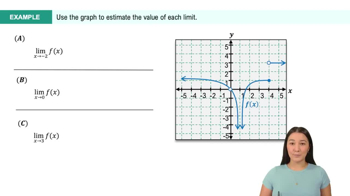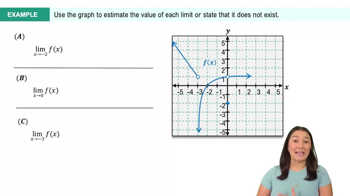Table of contents
- 0. Functions7h 52m
- Introduction to Functions16m
- Piecewise Functions10m
- Properties of Functions9m
- Common Functions1h 8m
- Transformations5m
- Combining Functions27m
- Exponent rules32m
- Exponential Functions28m
- Logarithmic Functions24m
- Properties of Logarithms34m
- Exponential & Logarithmic Equations35m
- Introduction to Trigonometric Functions38m
- Graphs of Trigonometric Functions44m
- Trigonometric Identities47m
- Inverse Trigonometric Functions48m
- 1. Limits and Continuity2h 2m
- 2. Intro to Derivatives1h 33m
- 3. Techniques of Differentiation3h 18m
- 4. Applications of Derivatives2h 38m
- 5. Graphical Applications of Derivatives6h 2m
- 6. Derivatives of Inverse, Exponential, & Logarithmic Functions2h 37m
- 7. Antiderivatives & Indefinite Integrals1h 26m
1. Limits and Continuity
Introduction to Limits
Problem 9a
Textbook Question
Let g(t)=t−3t−9.
Make two tables, one showing values of g for t=8.9,8.99, and 8.999 and one showing values of g for t=9.1,9.01, and 9.001.
 Verified step by step guidance
Verified step by step guidance1
Identify the function g(t) = \frac{t-9}{\sqrt{t}-3}. This function is undefined at t = 9 because both the numerator and the denominator become zero, leading to an indeterminate form.
To understand the behavior of g(t) as t approaches 9, we will evaluate the function for values of t slightly less than 9 and slightly greater than 9.
Create the first table for values of t less than 9: Calculate g(t) for t = 8.9, 8.99, and 8.999. For each value, substitute t into the function and simplify to find g(t).
Create the second table for values of t greater than 9: Calculate g(t) for t = 9.1, 9.01, and 9.001. Again, substitute each value of t into the function and simplify to find g(t).
Analyze the results from both tables to observe the trend of g(t) as t approaches 9 from both sides. This will help in understanding the limit of g(t) as t approaches 9.
Recommended similar problem, with video answer:
 Verified Solution
Verified SolutionThis video solution was recommended by our tutors as helpful for the problem above
Video duration:
5mPlay a video:
Was this helpful?

 6:47m
6:47mWatch next
Master Finding Limits Numerically and Graphically with a bite sized video explanation from Callie
Start learning





